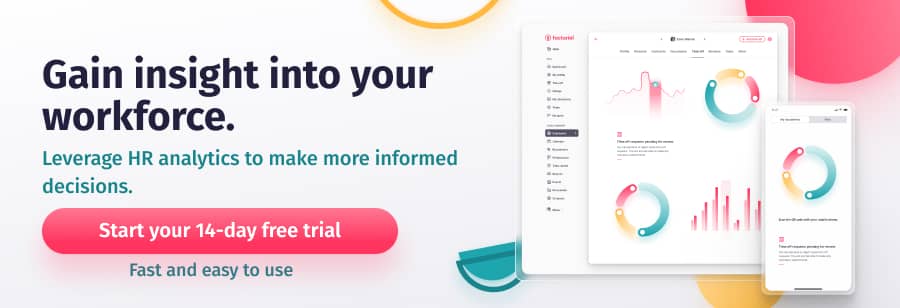Peer mentoring is a highly effective tool for encouraging employee development. Apart from helping your employees to advance in their careers, it can also strengthen team relationships, improve the quality of work, and create a more positive work environment. This is why 71% of Fortune 500 companies have mentoring programs.
Sadly, however, this figure drops drastically when it comes to the mainstream. In fact, according to a study conducted by Olivet Nazarene University, although 76% of surveyed professionals believe that mentors are important, only 37% currently have one. This needs to change.
In this article, we are going to take a closer look at what peer mentoring is and how creating a mentoring program in your company can benefit your business. We will also share some tips and examples to help you understand how to be a good peer mentor.
Related video: In this video, we explain the best practices to improve the employee onboarding process in 2022.
What is Peer Mentoring?
Let’s start with the most basic question: what is a peer mentor?
Peer mentoring is a form of workplace mentorship where employees are allocated a peer mentor who is at a similar level to them in the company, but who has different experiences and unique skills or knowledge to share. Peer mentoring usually forms a part of a company’s employee training and development strategy. The aim is to encourage the creation of supportive relationships where two people share their skills and experiences in order to learn from different perspectives.
It’s all about developing personal relationships that are built on trust and focused on achievement. This relationship helps peers support each other, learn from each other, and increase their skill sets. Think of it as reciprocal learning and development. Because of the interchangeable nature of the relationship, both parties assume the role of mentor and mentee. As a result, both employees can potentially grow and develop.
What Do Peer Mentors Do?
So, we’ve seen the theory, but what does it mean to be a peer mentor in practical terms?
A peer mentor does the following:
- Shares their knowledge, skills, and experience.
- Provides emotional and psychological support.
- Offers encouragement to less-experienced workers.
- Develops a personal, reciprocal relationship, built on trust and focused on achievement.
- Serves as a positive role model, using positive reinforcement to raise aspirations.
- Helps to nurture a positive company culture based on shared learning and collaboration.
- Demonstrates and teaches good communication and active listening skills.
- Facilitates employee training programs so that workers have access to the right tools, resources, and support to further their professional development.
- Motivates employees to make your workplace more productive.
The Benefits of a Peer Mentoring Program
There are a great number of benefits to promoting a peer mentoring program in your company. Amongst other things, it can boost your recruitment efforts, and increase your retention, engagement, and motivation levels. What’s more, when the right program is implemented, peer mentorship benefits the mentor, mentee, and employer. It’s a win-win for both you and your employees!
Let’s take a look at some of the biggest benefits of peer mentoring in the workplace:
- A peer mentoring program is a great way to transfer job-related knowledge and experience between employees. This makes it a highly efficient and cost-effective way to upskill and reskill your staff.
- Encouraging the use of peer mentors and workplace training can have a very positive effect on the well-being of your employees. This is because the relationship between a peer mentor and their mentee is based on trust, which often makes it more personal. This helps your employees feel comfortable enough to be open and honest about any issues or concerns they may have. And armed with this information, you can address potential problems before they become a bigger issue.
- Promoting the use of peer mentors also makes you appealing as an employer, helping you attract top talent to your company. Potential candidates will appreciate that you value employee learning and development, so it can be a decisive factor in a candidate’s decision to join your organisation.
- Peer mentoring has a positive effect on employee engagement and satisfaction levels. And this, in turn, has a positive impact on retention levels.
- Peer mentorship can help you create a climate of inclusivity, helping you to improve your DEI efforts.
- Finally, as your employees are able to turn to their mentors for advice, they make fewer mistakes on the job, reducing your losses as an employer.

How to Start a Peer Mentoring Program
There are a number of things to keep in mind when you create a peer mentoring program in your business. You need to consider what the program will look like, what your aims are, how you will offer support, and how you will monitor peer mentor relationships.
Let’s take a look at the process step by step.
Define Your Strategy & Objectives
As with any new initiative, your first step is establishing what your objectives are, and what strategy you will use to reach them. These will depend on the nature of your business and the primary issues you would like to address by promoting a peer mentoring program.
Are you looking to upskill or reskill certain departments due to changing business objectives? Would you like to improve overall performance and productivity levels? Or are you looking to boost retention levels and attract more top talent to your organisation?
Once you’ve established your goals, you need to conduct a training needs analysis to see what learning and development areas you need to address. You can also use several training methods to use in your L&D programs. This will also help you identify which employees are best placed to be mentors, and what strategy would work best to get you where you want to be.
Establish Structure, Guidelines & Expectations
The next step is establishing the structure, guidelines, and expectations of your peer mentoring program. In other words, you need to set some ground rules so that people understand what’s expected of them.
For instance, what format will you use? How frequently will employees attend mentoring meetings? What will they focus on during these meetings?
You should also consider how you are going to pair your mentors with their mentees. Will you assign pairing based on goals, abilities and achievements? Will you encourage cross-departmental pairing so that employees can interact with team members outside of their normal circle?

Spread the Word
Once you’ve created your peer mentoring program, you need to spread the word!
The best way to raise awareness is to post about your program on employee forums and company emails. If you have a noticeboard in the office, pin up an announcement to encourage employees to sign up. Don’t forget to include details about the program and how participants can become involved.
Foster a Culture of Learning
If your peer mentoring program is going to be a success, then you need to build a learning culture at every level of your organisation. Make sure you get all managers and department heads on board so that they can be advocates within their own areas. Encourage them to become peer mentors themselves!
It’s all about creating the right mindset so that everyone is eager to learn from each other and develop. Your employees need to understand that you value their development and that you are offering them an opportunity to grow.
Evaluate, Monitor & Measure
Finally, it would help if you established processes for evaluating, monitoring, and measuring the success of your peer mentoring program.
Create clear and measurable KPIs to see what impact your program is having on performance and retention levels. Keep a record of how the program shapes your company culture over time.
Perhaps the best way to measure the success of your program is by gathering regular feedback from your employees. Ask them what they think about the program and if they feel it is helping them grow and develop. Are they getting the support they need from their mentors? Would they recommend the program? Do your mentors feel that their mentees are taking full advantage of the opportunities offered to them through the program?
You can use Factorial’s skill matrix template to gather all the information you need to measure and monitor the success of your program.
Peer Mentoring Examples
Let’s finish by looking at a few examples of what you can get from a peer mentoring program.
Peer Mentoring for Goal Setting
With a peer mentorship program, both mentor and mentee can set their own goals for what they want to get from the experience. For example, the mentee may want support in improving their IT skills, whereas the mentor wants to strengthen their leadership skills. Both parties can align their needs and clarify what they expect to get from the relationship, then use this information to establish how best to structure their time.
Peer Mentoring for Accountability
Promoting the concept of mentorship is also a great way to encourage your employees to take accountability for their own learning and development, as well as that of their peers. And having a peer to work alongside makes them far more likely to engage with the program and encourage each other. And as one employee improves, the other will be motivated to develop too.
Peer Mentoring for Feedback & Collaboration
Finally, implementing a peer mentoring program in your business can be a great tool for encouraging communication and the sharing of constructive feedback. The program encourages employees to reflect on their development and any challenges they may be facing. And the sharing of open and transparent feedback will help you nurture a culture of collaboration and shared learning where employees are cheerleaders for their own development and that of their peers.





